组织行为学:OB模型
- 格式:docx
- 大小:102.71 KB
- 文档页数:3
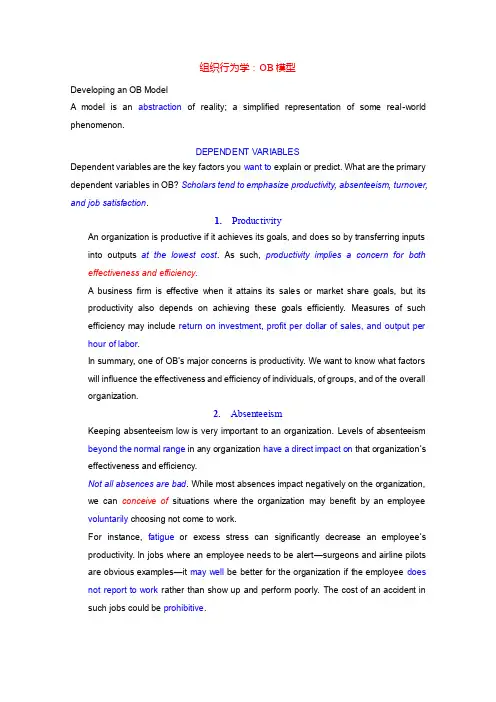
组织行为学:OB模型Developing an OB ModelA model is an abstraction of reality; a simplified representation of some real-world phenomenon.DEPENDENT VARIABLESDependent variables are the key factors you want to explain or predict. What are the primary dependent variables in OB? Scholars tend to emphasize productivity, absenteeism, turnover, and job satisfaction.1.ProductivityAn organization is productive if it achieves its goals, and does so by transferring inputs into outputs at the lowest cost. As such, productivity implies a concern for both effectiveness and efficiency.A business firm is effective when it attains its sales or market share goals, but itsproductivity also depends on achieving these goals efficiently. Measures of such efficiency may include return on investment, profit per dollar of sales, and output per hour of labor.In summary, one of OB's major concerns is productivity. We want to know what factors will influence the effectiveness and efficiency of individuals, of groups, and of the overall organization.2.AbsenteeismKeeping absenteeism low is very important to an organization. Levels of absenteeism beyond the normal range in any organization have a direct impact on that organization’s effectiveness and efficiency.Not all absences are bad. While most absences impact negatively on the organization, we can conceive of situations where the organization may benefit by an employee voluntarily choosing not come to work.For instance, fatigue or excess stress can significantly decrease an employee’s productivity. In jobs where an employee needs to be alert—surgeons and airline pilots are obvious examples—it may well be better for the organization if the employee does not report to work rather than show up and perform poorly. The cost of an accident in such jobs could be prohibitive.3.TurnoverVoluntary and involuntary permanent withdrawal from the organizationA high rate of turnover in an organization means increased recruiting, selection, andtraining costs. It can also mean a disruption in the efficient running of an organization when knowledgeable and experienced personnel leave and replacements must be found and prepared to assume positions of responsibility.Turnover often means the loss of people the organization does not want to lose. When turnover is excessive, or when it involves valuable performers, it can be disruptive factor, hindering the organization’s effectiveness.4.Job satisfactionJob satisfaction refers to a general attitude toward one’s job. The difference between the amount of rewards workers receive and the amount they believe they should receive.Job satisfaction represents an attitude rather than a behavior. The belief that satisfied employees are more productive than employees dissatisfied has been a basic tenet among managers for years.INDEPENDENT VARIABLESWhat are the major determinants of productivity, absenteeism, turnover, and job satisfaction? Our answer to that question brings us to the independent variables. Consistent with our belief that organizational behavior can best be understood when viewed essentially as a set of increasingly complex building blocks, the base or first level of our model lies in understanding individual behavior.1.Individual-level variablesPersonal or biographical characteristics such as age, gender, and marital status;personality characteristics; value and attitudes; basic ability level; Perception, individual decision making, learning, motivationThese characteristics are essentially intact when an individual enters the work force, and, for the most part, management can do little to alter them.2.Group-level variablesThe behavior of people in groups is more than the sum total of each individuals acting in their own way.The complexity of our model is increased when we acknowledge that people’s behavior when they are in groups is different from their behavior when they are alone. Therefore, the next step in the development of an understanding of OB is the study of group behavior.anizational system-level variablesJust as groups are more than the sum of their individual members, so are organizations more than the sum of their member groups.The design of the formal organization, technology and work processes, and jobs; the organization’s human resource policies and practices (that is, selection processes, training programs, and performance appraisal methods), the internal culture, and levels of work stress all have an impact on the dependent variables.。


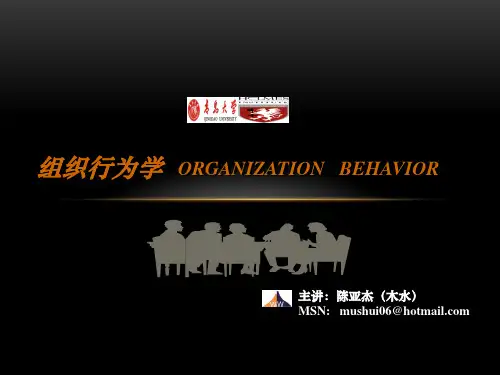

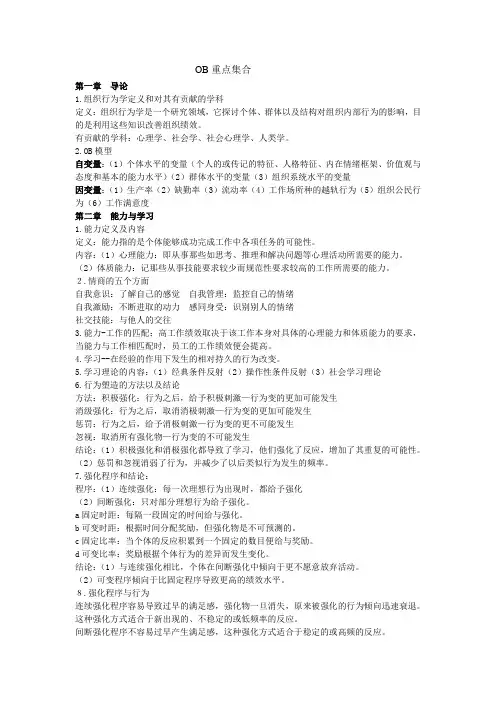
OB重点集合第一章导论1.组织行为学定义和对其有贡献的学科定义:组织行为学是一个研究领域,它探讨个体、群体以及结构对组织内部行为的影响,目的是利用这些知识改善组织绩效。
有贡献的学科:心理学、社会学、社会心理学、人类学。
2.OB模型自变量:(1)个体水平的变量(个人的或传记的特征、人格特征、内在情绪框架、价值观与态度和基本的能力水平)(2)群体水平的变量(3)组织系统水平的变量因变量:(1)生产率(2)缺勤率(3)流动率(4)工作场所种的越轨行为(5)组织公民行为(6)工作满意度第二章能力与学习1.能力定义及内容定义:能力指的是个体能够成功完成工作中各项任务的可能性。
内容:(1)心理能力:即从事那些如思考、推理和解决问题等心理活动所需要的能力。
(2)体质能力:记那些从事技能要求较少而规范性要求较高的工作所需要的能力。
2.情商的五个方面自我意识:了解自己的感觉自我管理:监控自己的情绪自我激励:不断进取的动力感同身受:识别别人的情绪社交技能:与他人的交往3.能力-工作的匹配:高工作绩效取决于该工作本身对具体的心理能力和体质能力的要求,当能力与工作相匹配时,员工的工作绩效便会提高。
4.学习--在经验的作用下发生的相对持久的行为改变。
5.学习理论的内容:(1)经典条件反射(2)操作性条件反射(3)社会学习理论6.行为塑造的方法以及结论方法:积极强化:行为之后,给予积极刺激—行为变的更加可能发生消级强化:行为之后,取消消极刺激—行为变的更加可能发生惩罚:行为之后,给予消极刺激—行为变的更不可能发生忽视:取消所有强化物—行为变的不可能发生结论:(1)积极强化和消极强化都导致了学习,他们强化了反应,增加了其重复的可能性。
(2)惩罚和忽视消弱了行为,并减少了以后类似行为发生的频率。
7.强化程序和结论:程序:(1)连续强化:每一次理想行为出现时,都给予强化(2)间断强化:只对部分理想行为给予强化。
a固定时距:每隔一段固定的时间给与强化。
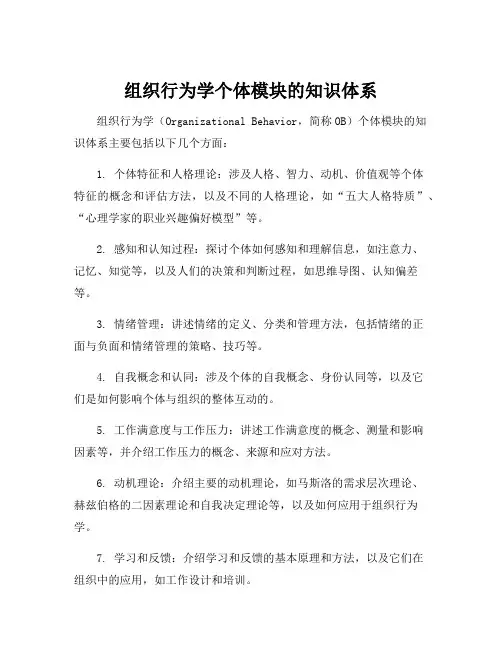
组织行为学个体模块的知识体系组织行为学(Organizational Behavior,简称OB)个体模块的知识体系主要包括以下几个方面:
1. 个体特征和人格理论:涉及人格、智力、动机、价值观等个体
特征的概念和评估方法,以及不同的人格理论,如“五大人格特质”、“心理学家的职业兴趣偏好模型”等。
2. 感知和认知过程:探讨个体如何感知和理解信息,如注意力、
记忆、知觉等,以及人们的决策和判断过程,如思维导图、认知偏差等。
3. 情绪管理:讲述情绪的定义、分类和管理方法,包括情绪的正
面与负面和情绪管理的策略、技巧等。
4. 自我概念和认同:涉及个体的自我概念、身份认同等,以及它
们是如何影响个体与组织的整体互动的。
5. 工作满意度与工作压力:讲述工作满意度的概念、测量和影响
因素等,并介绍工作压力的概念、来源和应对方法。
6. 动机理论:介绍主要的动机理论,如马斯洛的需求层次理论、
赫兹伯格的二因素理论和自我决定理论等,以及如何应用于组织行为学。
7. 学习和反馈:介绍学习和反馈的基本原理和方法,以及它们在
组织中的应用,如工作设计和培训。
8. 工作行为:讲述工作行为的概念和分类,如集体行为、组织公民行为、逆反行为等。
总之,组织行为学个体模块的知识体系围绕着个体的内在特征和行为方式展开,旨在帮助个人更好地理解和管理自己,从而更好地融入和贡献于组织。
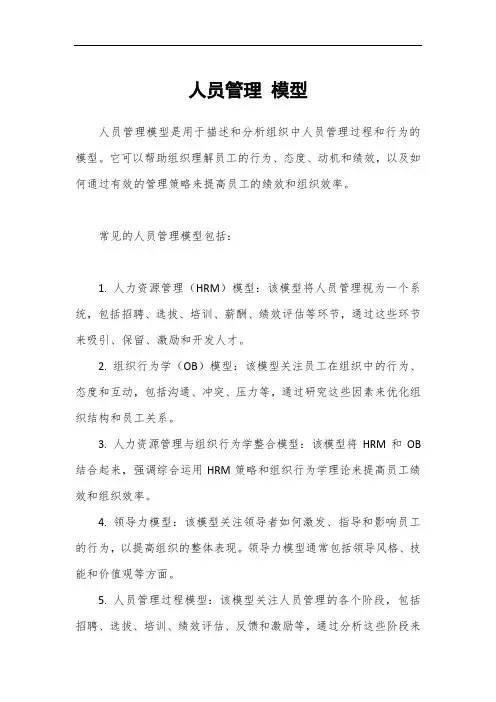
人员管理模型
人员管理模型是用于描述和分析组织中人员管理过程和行为的模型。
它可以帮助组织理解员工的行为、态度、动机和绩效,以及如何通过有效的管理策略来提高员工的绩效和组织效率。
常见的人员管理模型包括:
1. 人力资源管理(HRM)模型:该模型将人员管理视为一个系统,包括招聘、选拔、培训、薪酬、绩效评估等环节,通过这些环节来吸引、保留、激励和开发人才。
2. 组织行为学(OB)模型:该模型关注员工在组织中的行为、态度和互动,包括沟通、冲突、压力等,通过研究这些因素来优化组织结构和员工关系。
3. 人力资源管理与组织行为学整合模型:该模型将HRM和OB 结合起来,强调综合运用HRM策略和组织行为学理论来提高员工绩效和组织效率。
4. 领导力模型:该模型关注领导者如何激发、指导和影响员工的行为,以提高组织的整体表现。
领导力模型通常包括领导风格、技能和价值观等方面。
5. 人员管理过程模型:该模型关注人员管理的各个阶段,包括招聘、选拔、培训、绩效评估、反馈和激励等,通过分析这些阶段来
优化人员管理的流程和效果。
这些模型的应用可以帮助组织更好地理解员工需求,提高员工满意度和绩效,同时也可以帮助组织制定更加科学和有效的管理策略。


组织行为学模型
组织行为学(organizationbehavior,OB)是一个研究领域,他研究组织行为中德三个因素:个体、群体和架构。
组织行为学关注人们在组织中做什么以及这种行为如何影响组织的绩效。
目前虽然人们对于各项内容的权重依然有争论,但是组织行为学中的核心课题大家基本已达成共识,这些课题包括动机、领导行为和权利、人际沟通、群体结构与过程、学习、态度形成和知觉、变革过程、冲突、工作设计及工作压力。
在开始需要界定两个概念:管理者和组织。
管理者是通过别人来完成工作,管理者在组织中完成他们的工作,组织是一个人们有目的的组合起来的社会单元,由于是接着前面五篇管理学那些事已经详细阐述了管理者的各个方便,这里就不赘述。
— 1 —。
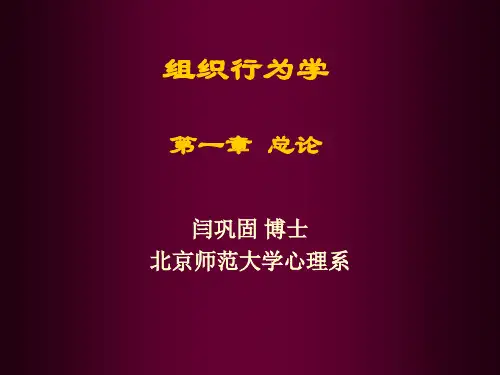
ob组织行为学名词解释1. 什么是组织行为学?组织行为学(Organizational Behavior,简称OB)是一门研究关于员工行为和组织结构的学科。
它探讨着个人、小组和整个组织在工作环境中的行为模式和动态。
OB结合了心理学、社会学和管理学等学科,以探究影响员工和组织绩效的各种因素。
2. 理解个体行为在组织行为学中,个体行为是关键的研究对象之一。
要全面理解个体行为,我们需要关注以下几个方面:a) 个体如何处理和适应工作压力和挑战?b) 个体如何做出决策和解决问题?c) 个体如何与同事和上级进行有效的沟通和协作?d) 个体如何平衡工作和个人生活?这些问题涉及到个体的意识、态度、动机和价值观等因素。
个体行为的研究可以帮助我们理解员工的需求、能力和动力,从而提高员工的绩效、满意度和工作质量。
3. 小组行为的重要性除了个体行为,小组行为也是组织行为学的关注点之一。
小组是组织中最基本的单位,它由互相协作的个体组成。
小组的研究可以帮助我们理解以下几个方面:a) 小组如何建立和维护良好的协作关系?b) 小组如何进行决策和解决冲突?c) 小组如何分配和协调工作任务?通过研究小组行为,我们可以提高团队的凝聚力、效率和创新力。
了解小组行为还有助于我们设计和实施有效的团队培训和组织发展计划。
4. 组织的结构和文化除了个体行为和小组行为,组织的结构和文化也是组织行为学的重要组成部分。
组织的结构涉及到职权和责任的分配、信息流动的路径以及决策的层级等方面。
组织的文化指的是共同的价值观、信念和行为规范。
研究组织结构和文化可以帮助我们理解以下几个方面:a) 组织如何通过结构来促进协作和沟通?b) 组织如何塑造和传递其核心价值观和行为规范?c) 组织如何应对和适应外部环境的变化?通过研究组织的结构和文化,我们可以优化组织的效率和灵活性,增强员工的认同感和忠诚度。
总结回顾:组织行为学是一门综合性学科,它研究的是员工行为和组织结构。
组织行为学:OB模型Developing an OB ModelA model is an abstraction of reality; a simplified representation of some real-world phenomenon.DEPENDENT VARIABLESDependent variables are the key factors you want to explain or predict. What are the primary dependent variables in OB? Scholars tend to emphasize productivity, absenteeism, turnover, and job satisfaction.1.ProductivityAn organization is productive if it achieves its goals, and does so by transferring inputs into outputs at the lowest cost. As such, productivity implies a concern for both effectiveness and efficiency.A business firm is effective when it attains its sales or market share goals, but itsproductivity also depends on achieving these goals efficiently. Measures of such efficiency may include return on investment, profit per dollar of sales, and output per hour of labor.In summary, one of OB's major concerns is productivity. We want to know what factors will influence the effectiveness and efficiency of individuals, of groups, and of the overall organization.2.AbsenteeismKeeping absenteeism low is very important to an organization. Levels of absenteeism beyond the normal range in any organization have a direct impact on that organization’s effectiveness and efficiency.Not all absences are bad. While most absences impact negatively on the organization, we can conceive of situations where the organization may benefit by an employee voluntarily choosing not come to work.For instance, fatigue or excess stress can significantly decrease an employee’s productivity. In jobs where an employee needs to be alert—surgeons and airline pilots are obvious examples—it may well be better for the organization if the employee does not report to work rather than show up and perform poorly. The cost of an accident in such jobs could be prohibitive.3.TurnoverVoluntary and involuntary permanent withdrawal from the organizationA high rate of turnover in an organization means increased recruiting, selection, andtraining costs. It can also mean a disruption in the efficient running of an organization when knowledgeable and experienced personnel leave and replacements must be found and prepared to assume positions of responsibility.Turnover often means the loss of people the organization does not want to lose. When turnover is excessive, or when it involves valuable performers, it can be disruptive factor, hindering the organization’s effectiveness.4.Job satisfactionJob satisfaction refers to a general attitude toward one’s job. The difference between the amount of rewards workers receive and the amount they believe they should receive.Job satisfaction represents an attitude rather than a behavior. The belief that satisfied employees are more productive than employees dissatisfied has been a basic tenet among managers for years.INDEPENDENT VARIABLESWhat are the major determinants of productivity, absenteeism, turnover, and job satisfaction? Our answer to that question brings us to the independent variables. Consistent with our belief that organizational behavior can best be understood when viewed essentially as a set of increasingly complex building blocks, the base or first level of our model lies in understanding individual behavior.1.Individual-level variablesPersonal or biographical characteristics such as age, gender, and marital status;personality characteristics; value and attitudes; basic ability level; Perception, individual decision making, learning, motivationThese characteristics are essentially intact when an individual enters the work force, and, for the most part, management can do little to alter them.2.Group-level variablesThe behavior of people in groups is more than the sum total of each individuals acting in their own way.The complexity of our model is increased when we acknowledge that people’s behavior when they are in groups is different from their behavior when they are alone. Therefore, the next step in the development of an understanding of OB is the study of group behavior.anizational system-level variablesJust as groups are more than the sum of their individual members, so are organizations more than the sum of their member groups.The design of the formal organization, technology and work processes, and jobs; the organization’s human resource policies and practices (that is, selection processes, training programs, and performance appraisal methods), the internal culture, and levels of work stress all have an impact on the dependent variables.。